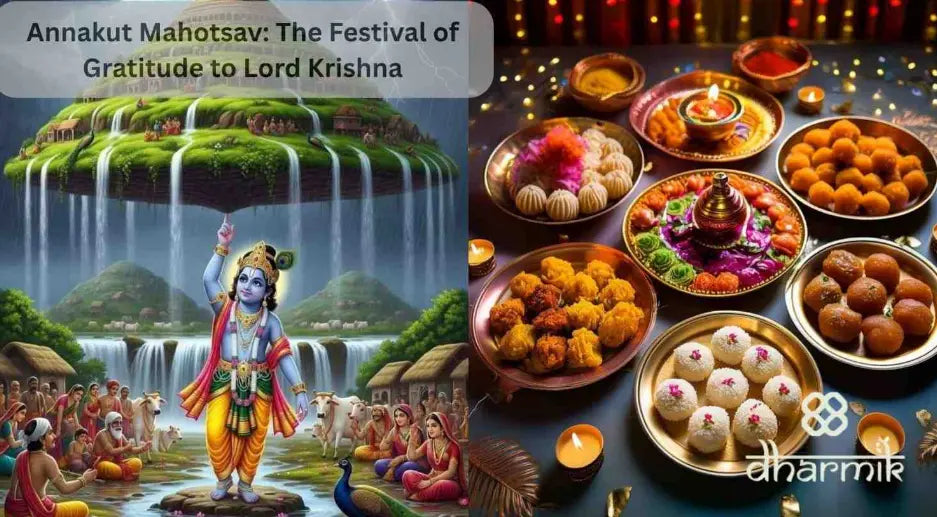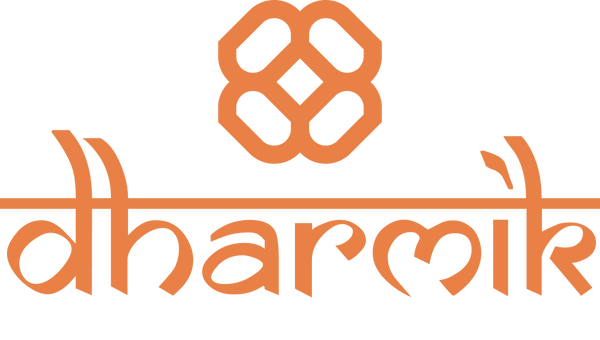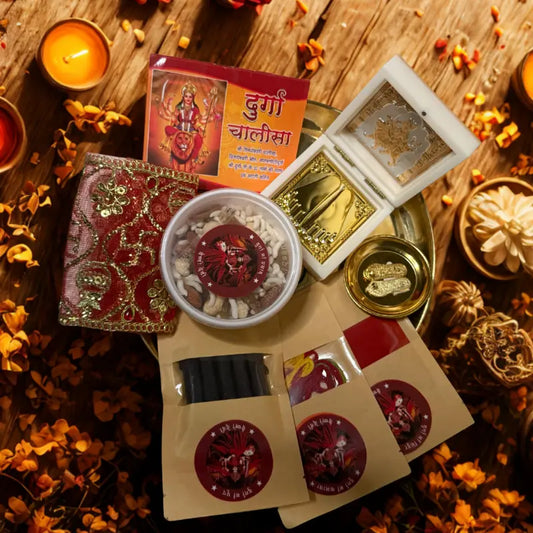
Annakut Mahotsav: The Festival of Gratitude to Lord Krishna
Share
Govardhan holds a sacred place in Hindu traditions, symbolizing divine protection and abundance. Every year, devotees celebrate the Annakut festival to honor Lord Krishna’s legendary act of lifting the Govardhan hill to protect villagers from torrential rains. This festival is not just a ritual—it is an expression of gratitude, devotion, and spiritual joy, where food, prayers, and community celebrations come together in a vibrant display of faith.
Central to this observance is the preparation of Chhappan Bhog, meaning “56 delicacies,” representing the divine blessings and prosperity that Krishna bestows upon his devotees.

The Spiritual Significance of Annakut Mahotsav
The Annakut festival, also known as Govardhan Puja, marks the day when Lord Krishna lifted the Govardhan hill to protect villagers from torrential rains sent by Indra, the king of gods. By creating a large mound of food, devotees symbolically offer gratitude to Krishna for his blessings and protection. This act of devotion emphasizes the importance of humility, gratitude, and selfless service in the spiritual lifestyle of devotees.
The festival is not only about rituals; it embodies the core of Indian spiritual traditions where food becomes a medium to express love and reverence. Devotees meticulously prepare various dishes, collectively forming a massive offering called Chhappan Bhog, meaning “56 delicacies,” which signifies the abundance of blessings and prosperity.
Historical Roots of Govardhan Worship
The legend of Govardhan dates back to the epic tales of Lord Krishna's life in Vrindavan. Heavy rains threatened the residents of Braj, so Krishna instructed them to seek shelter under the Govardhan hill instead of worshiping Indra. This divine act highlighted Krishna’s role as a protector and reinforced the importance of devotion over ritualistic practices.
Over centuries, devotees have commemorated this event through the Annakut festival, symbolically recreating the hill with an offering of numerous food items. Temples worldwide now organize grand celebrations, arranging thousands of dishes in artistic displays to inspire devotion and community spirit.
The Rituals of Annakut Festival
Celebration of the Annakut festival typically begins with a spiritual cleaning of homes and temples, followed by early morning prayers. Devotees decorate altars with flowers, lights, and miniature representations of Govardhan. The preparation of food is both a religious and artistic practice.
Key rituals include:
-
Offering Govardhan puja bhog items, a symbol of gratitude for abundance, is a key ritual.
-
The celebration also involves the recitation of Krishna's divine leelas and the chanting of hymns.
- Performing Aarti and singing devotional songs praising Krishna’s protection and kindness.
-
Devotees often enhance their home altars with divine mementos to make the celebration more special. Items like Krishna Ji Charan—gold plated—which bring a spiritual ambiance to the Annakut setup, making the puja more heartfelt and memorable.
The festival fosters a sense of unity, as families and communities come together to prepare the Chhappan Bhog, creating a visual feast for both devotees and deities.
Culinary Devotion: Chhappan Bhog
A central highlight of Annakut is the Chhappan Bhog, meaning fifty-six different food items offered to Lord Krishna. This tradition signifies the limitless devotion of devotees and the vast blessings of the divine. The Govardhan puja bhog items often include:
-
Savory dishes such as khichdi, dal, and vegetable curries.
-
Sweet preparations like laddoos, pedas, and kheer.
-
Special seasonal delicacies representing local culinary traditions.
Each item is meticulously arranged, not just for consumption but as a form of artistic expression and spiritual offering, symbolizing the abundance of nature and divine grace.
The Global Celebration of Annakut Festival
While Annakut originated in Braj, it is now celebrated in various ISKCON temples and communities worldwide. Devotees across continents observe the festival with equal enthusiasm, adapting local ingredients while maintaining the sanctity of traditions.
The festival offers a chance for devotees to experience Govardhan in a symbolic form and reflect upon the teachings of Krishna. Community feasts are organized where the prepared Govardhan Puja bhog items are later distributed as prasadam, which encourages charitable behavior and unity among participants.

Spiritual Lessons from Govardhan Puja
The celebration of Govardhan goes beyond rituals; it conveys profound spiritual messages:
-
Gratitude: Recognizing divine blessings in daily life.
-
Protection: Trusting in divine guidance during challenges.
-
Community Spirit: Collective preparation and sharing of food strengthens social bonds.
-
Environmental Awareness: Worshiping the hill emphasizes respect for nature.
Through these lessons, the Annakut festival becomes more than a cultural event—it becomes a reminder of living a conscious and spiritually aligned life.
How to Celebrate Annakut at Home
Even those who cannot attend temple festivities can partake in Annakut at home. Here’s a simplified way:
-
Clean your home and set up a small altar for Krishna.
-
Prepare a mini Chhappan Bhog using your favorite dishes.
-
Offer the Govardhan puja bhog items to Krishna with devotion.
-
Chant prayers and sing bhajans to enhance the spiritual ambiance.
- Share the prepared food with family, friends, and neighbors.
-
To make your home celebration even more divine, you can place a Krishna Darbar idol near the mini Govardhan setup. These sacred items help devotees feel closer to Lord Krishna while offering the Chhappan Bhog.
This home-based celebration not only honors Krishna but also brings spiritual energy into the household.
FAQs About Annakut Mahotsav
Q1: What is the Annakut festival?
A: Annakut festival is a celebration of gratitude to Lord Krishna, marked by offering a vast variety of food items, symbolically recreating the Govardhan hill.
Q2: What is the Chhappan Bhog meaning?
A: "Chhappan Bhog" refers to fifty-six different delicacies prepared and offered to Lord Krishna as part of the Annakut celebrations.
Q3: Which are common Govardhan Puja bhog items?
A: Popular Govardhan Puja bhog items include khichdi, sweets like laddoos and pedas, kheer, vegetable curries, and seasonal dishes representing abundance.
Q4: When is the Annakut festival celebrated?
A: Annakut is observed a day after Diwali, during the Hindu month of Kartik, coinciding with Govardhan Puja.
Q5: Can Annakut be celebrated at home?
A: Yes, devotees can prepare a home altar, offer mini Chhappan Bhog, chant prayers, and distribute prasadam to family and friends.
Final Thoughts
The Annakut festival is a beautiful confluence of devotion, culture, and culinary art. Through the worship of Govardhan and the offering of Govardhan puja bhog items, devotees express deep gratitude and strengthen their spiritual connection with Lord Krishna. Celebrating the Chhappan Bhog embodies the values of abundance, community, and mindfulness. Whether in grand temples or at home, Annakut Mahotsav is a timeless reminder of the joys of giving, devotion, and gratitude—a festival where food becomes a pathway to spiritual fulfillment.
By embracing these traditions, devotees not only honor Krishna but also integrate the teachings of devotion, service, and harmony into daily life, making Annakut a celebration that transcends generations.
👉 Order Your Vrindavan Prasad Box Here:




